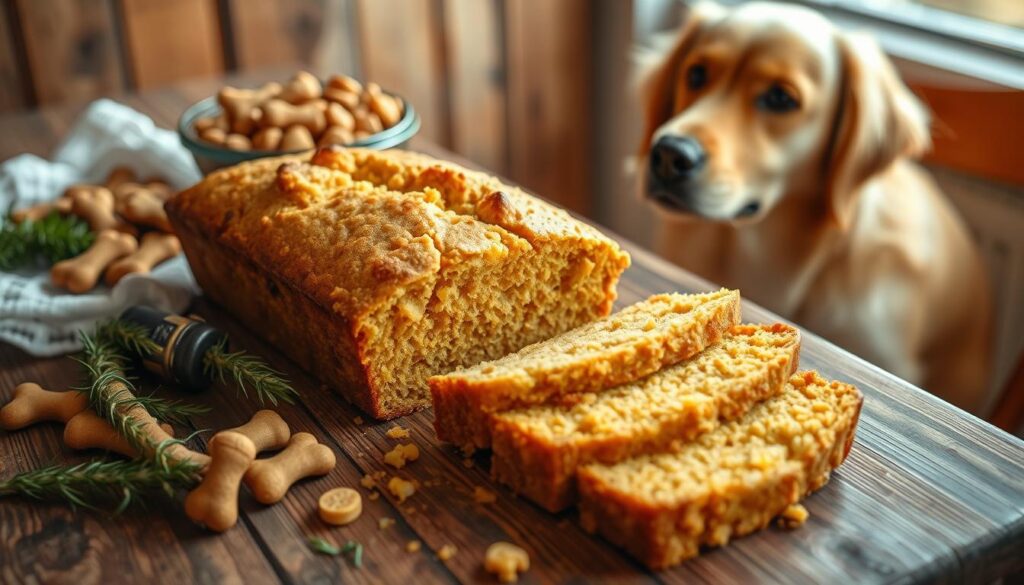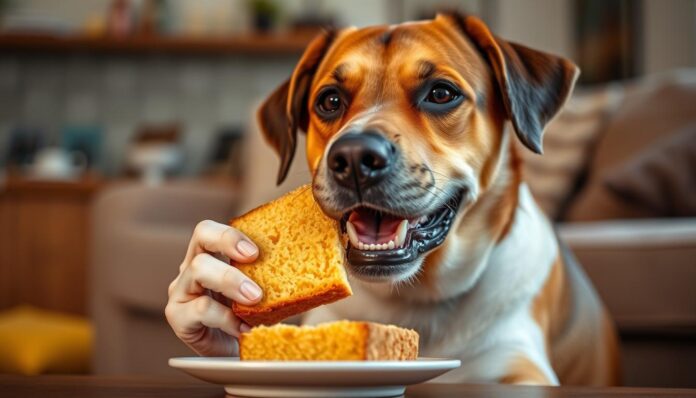Many pet parents wonder about sharing their favorite comfort foods with their furry friends. Cornbread, a beloved treat, often sparks questions about its safety. At Top Dog Retrievers, we’ve been your trusted source for pet health advice since 2012, offering insights backed by expert veterinarians.
Cornbread recipes vary widely, and its safety depends on ingredients and portion sizes. While it might seem harmless, certain components like sugar, butter, or spices can pose risks. Our goal is to help you make informed decisions about your pet’s diet.
In this article, we’ll explore the benefits, risks, and safe practices for feeding cornbread. We’ll also share dog-friendly alternatives to ensure your pet stays healthy and happy. Trust us to guide you with reliable, vet-approved advice.
Key Takeaways
- Cornbread safety depends on its ingredients and portion sizes.
- High sugar or fat content can harm your pet’s health.
- Always consult a vet before introducing new foods.
- Homemade recipes can be safer by avoiding harmful additives.
- Healthier alternatives like sweet potatoes or pumpkin are great options.
Benefits and Risks of Sharing Cornbread with Your Dog
When it comes to sharing human food with pets, cornbread often raises questions. While it might seem like a harmless treat, understanding its nutritional value and potential risks is crucial. At Top Dog Retrievers, we’re here to guide you with vet-approved advice to ensure your pet’s health and happiness.
Nutritional Insights and Limitations
Cornbread typically contains basic ingredients like cornmeal, wheat flour, and eggs. These components can provide some vitamins and minerals. However, many recipes include additives like sugar, butter, or spices that can be harmful. For example, high sugar levels can lead to obesity and dental issues, while butter may upset a sensitive stomach.
It’s important to note that cornbread doesn’t offer significant health benefits for pets. While corn itself is generally safe, the added ingredients often outweigh any potential positives. Always check the ingredient list to avoid harmful additives like onions or garlic, which can be toxic even in small amounts.
Potential Digestive Reactions
Pets have delicate digestive systems, and certain ingredients in cornbread can cause adverse reactions. Common signs include vomiting, diarrhea, or skin irritations. These symptoms may indicate a food allergy, especially if your pet is sensitive to grains like wheat or corn.
Moderation is key. Even if your pet enjoys cornbread, it should only be given in very small amounts. Overconsumption can lead to gastrointestinal distress or more severe health issues. For safer alternatives, consider healthier options like sweet potatoes or.
If you notice any unusual symptoms after feeding cornbread, consult your veterinarian immediately. They can provide personalized advice based on your pet’s unique needs.
Can Dogs Eat Cornbread? Understanding Safe Practices
Sharing a slice of cornbread with your furry companion might seem harmless, but it’s essential to know the facts. While this treat can be enjoyed in moderation, certain ingredients and practices can pose risks. At Top Dog Retrievers, we’re here to guide you through safe feeding habits to keep your pet healthy.
Essential Ingredients to Avoid
Not all cornbread recipes are created equal. Some ingredients commonly found in human food can be harmful to your pet. Avoid additives like onions, garlic, and hot spices, as they can cause serious health issues. Even store-bought mixes may contain preservatives or artificial flavors that aren’t suitable for your animal.
Wheat, a common ingredient in cornbread, can also be problematic for some pets. If your furry friend has a sensitive stomach or grain allergies, it’s best to steer clear. Always check the label or recipe to ensure it’s free from harmful components.
Assessing Portion Size and Frequency
When it comes to feeding your pet cornbread, moderation is key. A small amount, such as a bite-sized piece, is generally safe. However, overfeeding can lead to digestive problems or weight gain. Treats like this should never replace a balanced diet tailored to your pet’s needs.
If you’re considering homemade recipes, they’re often a safer choice. You can control the ingredients and avoid unnecessary additives. For store-bought options, always read the label carefully to ensure it’s free from harmful substances.
Remember, every pet is unique. If you notice any issues after feeding cornbread, such as vomiting or diarrhea, consult your veterinarian immediately. For more tips on maintaining a balanced diet, explore our resources.
How to Prepare Cornbread as a Safe Treat for Your Dog
With a few simple adjustments, you can turn cornbread into a pet-friendly delight. Preparing a homemade recipe ensures you control the ingredients, making it a safer snack for your furry friend. Let’s explore how to modify traditional recipes to suit your pet’s needs.

Dog-Friendly Recipe Adjustments
When adapting a cornbread recipe, start by removing harmful ingredients. Avoid sugar, butter, and excessive salt, which can cause health issues. Instead, use small amounts of vegetable oil and natural sweeteners like unsweetened applesauce.
Here’s a basic list of safe and unsafe ingredients:
| Safe Ingredients | Ingredients to Avoid |
|---|---|
| Cornmeal | Sugar |
| Whole wheat flour | Butter |
| Unsweetened applesauce | Onions |
| Vegetable oil | Garlic |
| Eggs | Artificial flavors |
Tips for Homemade Cornbread
Baking a pet-friendly snack requires attention to detail. Reduce the amount of salt and sugar in the recipe to make it healthier. Use whole wheat flour instead of refined flour for added fiber.
Here are some additional tips:
- Let the cornbread cool completely before serving.
- Cut it into small, bite-sized pieces to prevent choking.
- Monitor your pet after introducing the new treat.
For more insights on pet care, explore our guide to pet health. By following these steps, you can create a delicious and safe snack your pet will love.
Guidelines from Trusted Veterinarians on Pet Health
Ensuring your pet’s health requires guidance from trusted veterinarians. At Top Dog Retrievers, we rely on expert advice to help you make informed decisions about your furry friend’s diet and well-being. Whether it’s occasional treats or daily meals, understanding the right strategies is key to keeping your pet healthy.
Vet-Recommended Feeding Strategies
Veterinarians emphasize the importance of moderation when it comes to treats. While occasional snacks like cornbread can be enjoyed, they should never replace a balanced diet. Here are some vet-approved strategies:
- Limit treats to less than 10% of your pet’s daily caloric intake.
- Choose smaller portions to avoid overfeeding.
- Opt for homemade recipes to control ingredients and avoid harmful additives.
These practices ensure your furry friend stays healthy without compromising their nutritional needs.
Monitoring Your Pet’s Health After Treats
Introducing new foods requires careful observation. Watch for any signs of discomfort, such as digestive upset or skin irritations. These could indicate an adverse reaction. Common symptoms include vomiting, diarrhea, or changes in behavior.
If you notice any of these signs, consult your veterinarian immediately. Regular check-ups, recommended year after year, are essential for catching potential issues early. For more tips on maintaining your pet’s health, explore our guide to dental care.
By staying vigilant and following expert advice, you can ensure your pet remains happy and healthy for years to come.
Parting Advice for a Healthy and Happy Pet
Your pet’s health and happiness depend on the choices you make as a caring owner. While sharing a human treat like cornbread can be a special thing, moderation is key. Always prioritize their daily nutrition over occasional snacks.
Being a responsible pet owner means staying informed. When in doubt, consult your veterinarian to ensure your friend stays safe. Every decision you make impacts their well-being, so choose wisely.
We encourage you to share your experiences and questions. Every pet parent’s journey is unique, and we’re here to support you every step of the way. For more tips on maintaining a balanced diet, explore our guide to safe treats.
Remember, every human choice made with care strengthens the bond between you and your pet. Together, we can ensure a lifetime of health and happiness for your beloved friend.
















